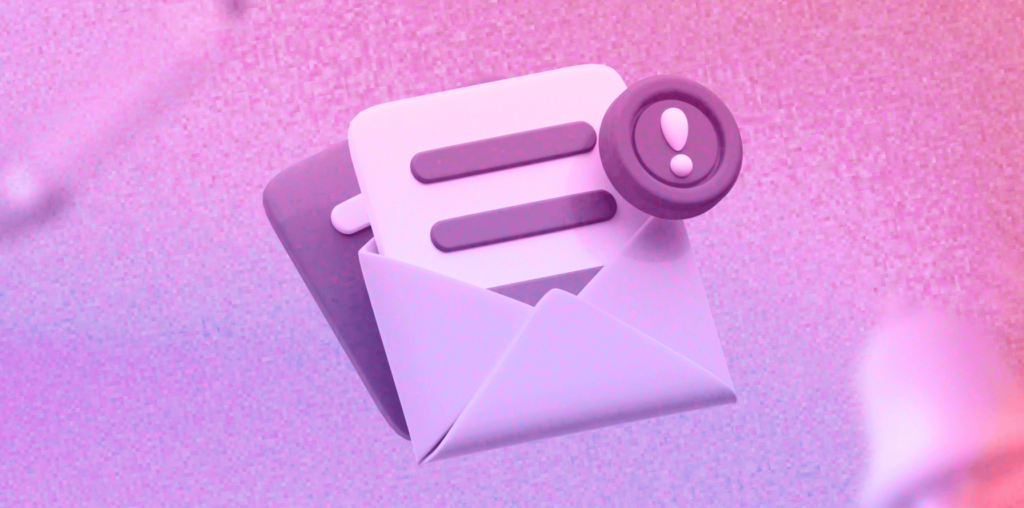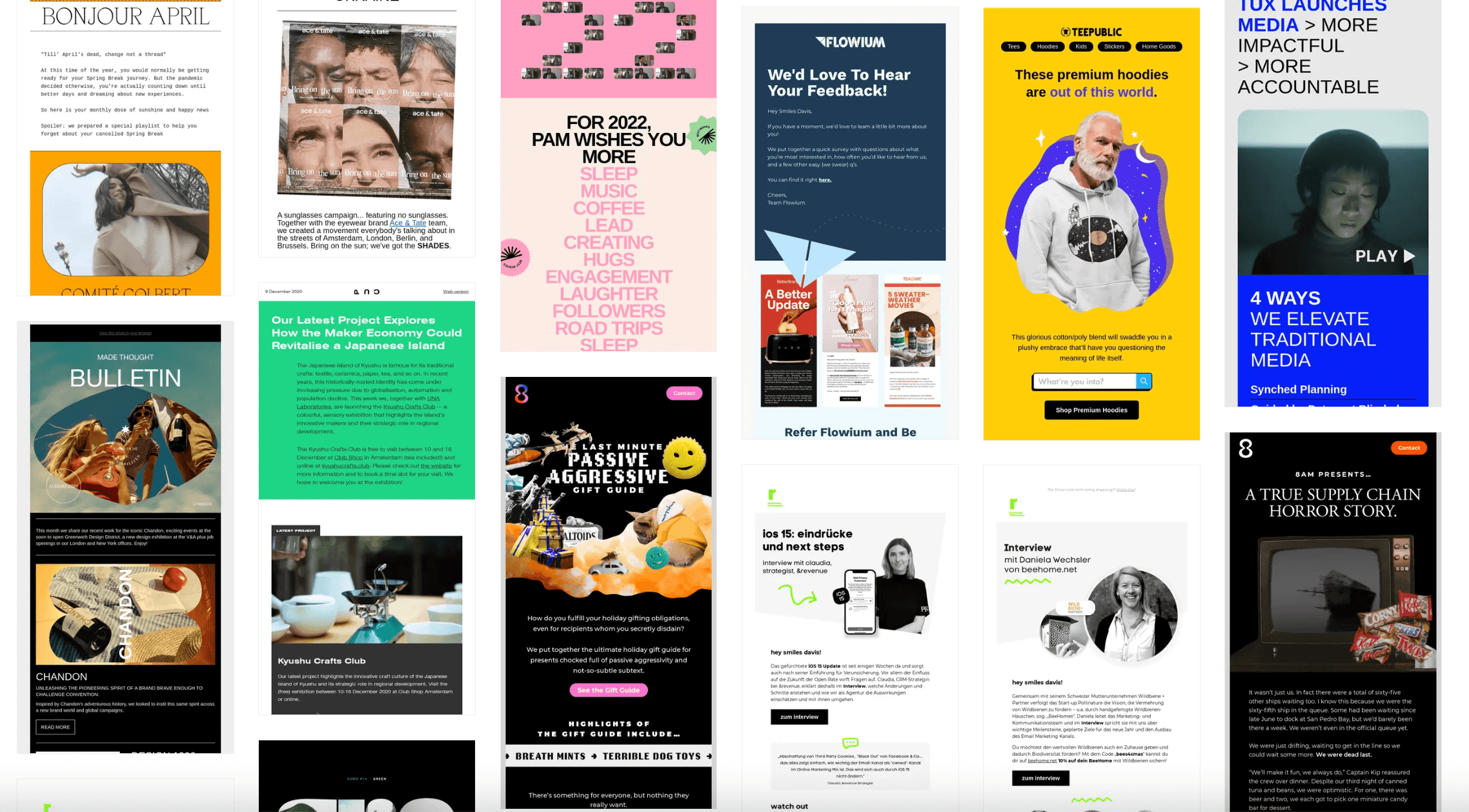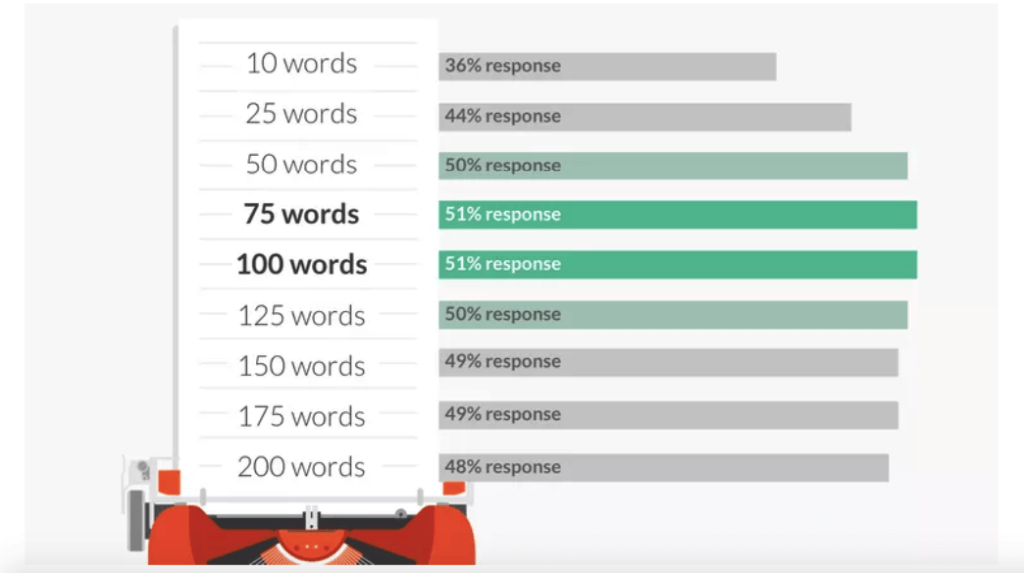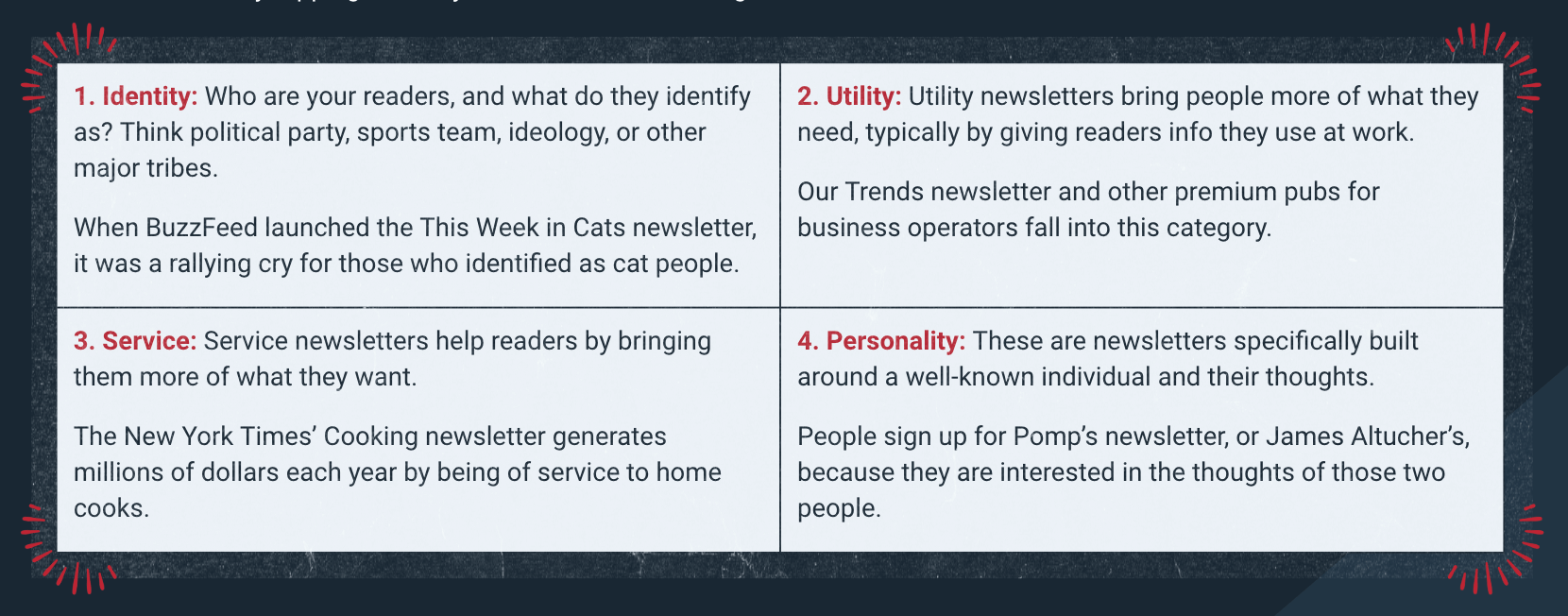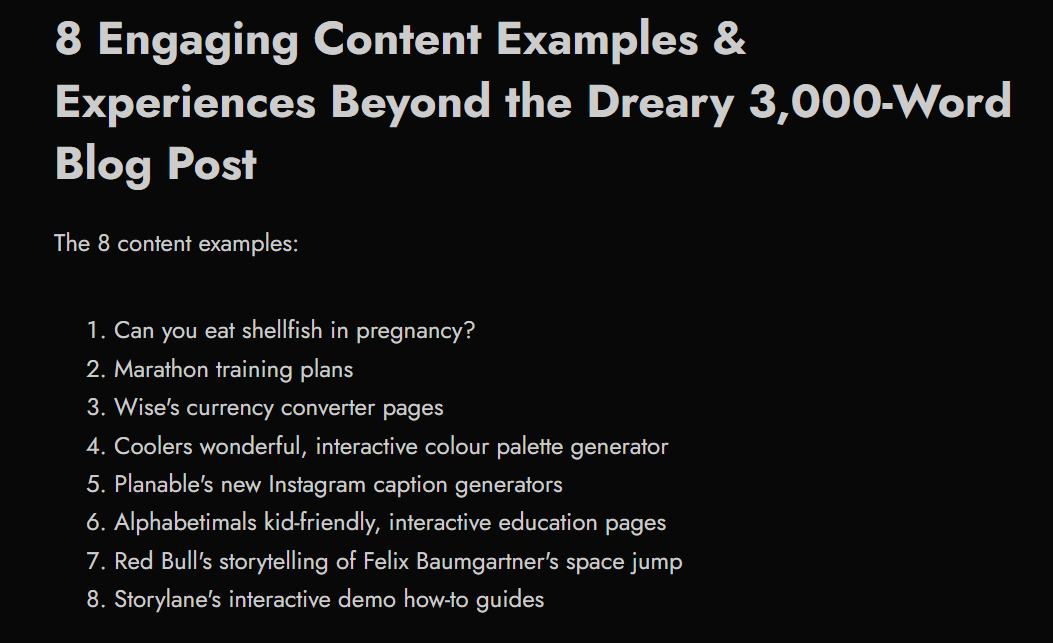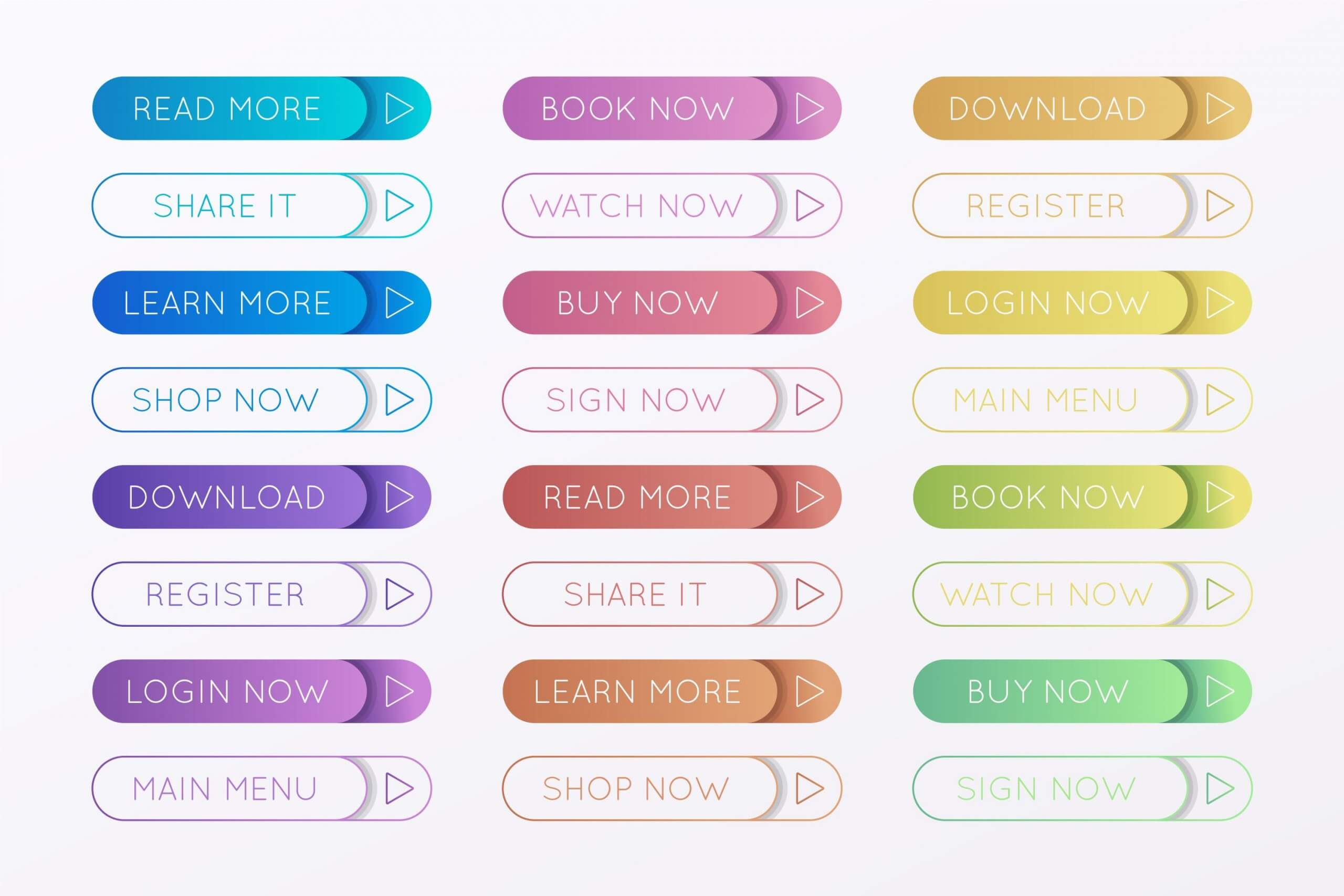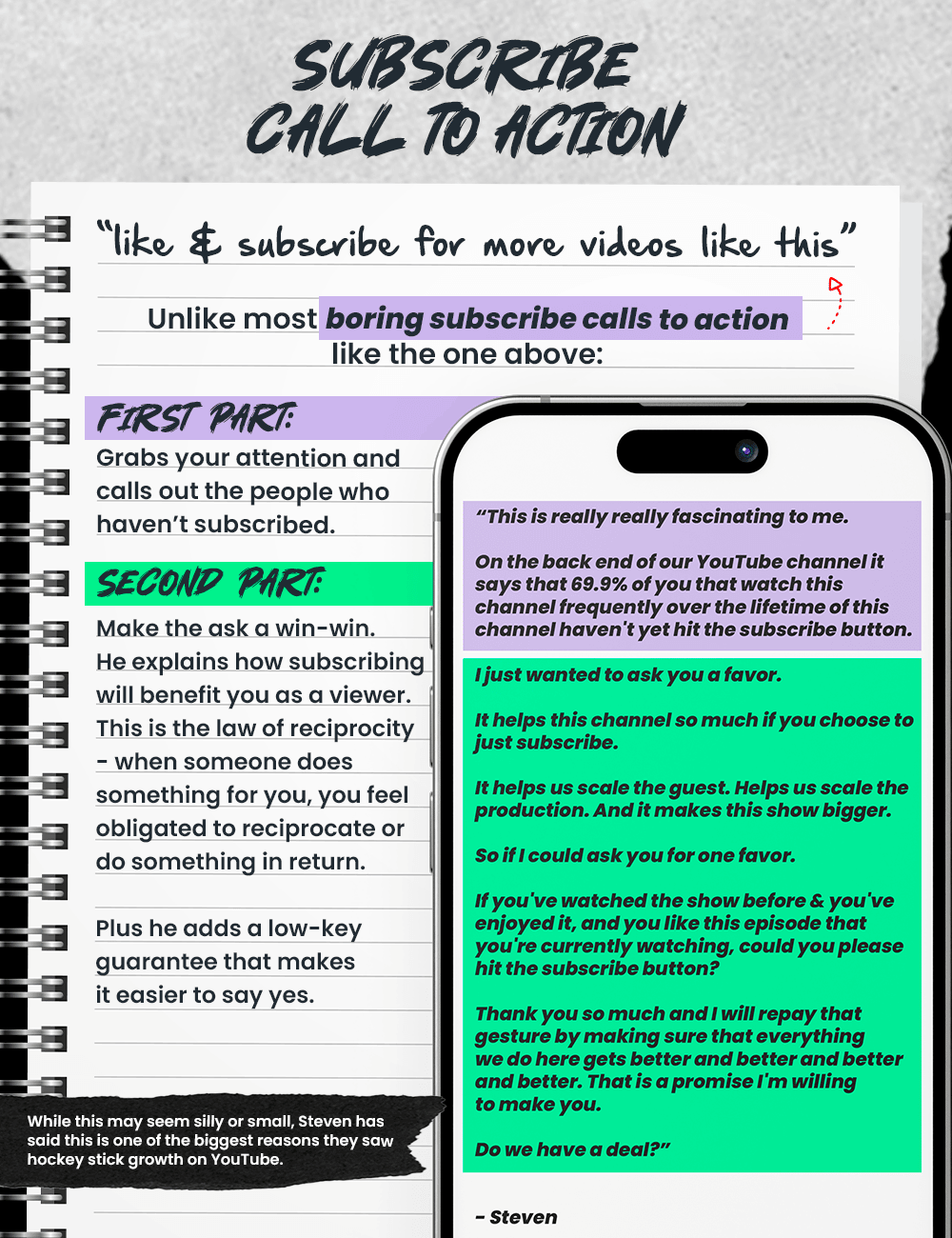Not too long ago, everyone was discussing how email marketing is a thing of the past. Then, digital marketing specialists everywhere realized, and I quote, that “Email marketing is not dead.” Frankly, I agree. I’ve seen firsthand how emails, especially newsletters, can show great ROI if done right. So today, I’m here to show you what proper newsletter content creation entails using some of the top content planning tools.
Why newsletters? Because they’re great. They offer an avenue to build relationships with your audience, drive traffic to your website, and increase brand awareness – all from the same channel. Let’s get into it.
What is a newsletter?
A newsletter is a regularly scheduled communication, usually sent via email, that delivers tailored, curated content directly to subscribers’ inboxes. This type of communication includes news, updates, promotions, user-generated content like peer reviews, or any other valuable and relevant resources. A newsletter keeps your audience informed and engaged, builds relationships, and drives action.
But how do you make your newsletter stand out? Factors like content relevance, design, and personalization influence its success.
What type of content should your newsletter contain?
There is no one-size-fits-all type of newsletter. However, most of them have recurring sections such as:
Many businesses share their most recent blogs through their newsletters to drive traffic to their website.
Promoting events in an email newsletter is one of the most effective ways to drive RSPVs to a whole new level and grow awareness around the experience.
- Featured customer stories
These are great because they show your recipients that business is going well and that you value your customers while nurturing current relationships.
This is a highly appreciated way to position yourself as a thought leader or expert on a matter while giving away free knowledge.
- Other value-packed resources
This includes interviews, knowledge curation, or useful tips, which have the same purpose of building thought leadership.
How much content should be in a newsletter?
While quality will always triumph over quantity, there are some best practices when it comes to the ideal newsletter word count. But if you find you have more content that exceeds this ideal word count and is still valuable, there are a couple of strategies you can use:
- Incorporate it into your email newsletters’ body while still sticking to a reasonable word count in a short, concise manner. Remember, you can also split a larger amount of content into a series of several newsletters on the topic.
- Incorporate it into blog posts, which you can post on your website, and then link to from your email newsletters.
Leigh McKenzie, Community Advocate at Traffic Think Tank, advises:
Go deep. Focus your newsletter to be all about quality over quantity. You have to really make its value indisputable to stand out these days, and even then, it’ll take time to find your USP footing.
So, what’s the ideal word count for an email newsletter?
After reviewing all major studies on this matter, it seems that you should go up to 200 words with your email communications. In fact, a study on over 40 million emails shows that email copies of around 75-100 words hit the sweetest spot regarding response rates.
So, the key to a successful email marketing campaign is to stick to simple, concise, value-driven communications. If you want to assess whether this tactic will work, try running A/B tests to see which performs better.
How to write a newsletter in 9 simple steps
Follow this 9-step guide to newsletter planning to craft content that resonates with your audience, drives action, and builds lasting relationships.
Let’s dive in.
1. Define your target audience and goals
Before you begin writing anything, you need to research and define your target audience. This will help you build a newsletter structure, and include the right content, to achieve your goals.
So, before you dive into email newsletter creation, answer these questions:
- Are you speaking to potential customers, existing clients, or an industry peer group?
- What are the main interests of the people you’re trying to reach?
- What are their day-to-day jobs, functions, and occupations?
All these questions will help you define the status, knowledge level, and topics of interest of your target audience. This will also help you tailor your content and tone. That’s when you’ll be able to head to the next step: defining your newsletter’s purpose.
Are you looking to drive sales, increase brand awareness, or offer valuable information as a hobby?
Knowing who your audience is and what you want to tell them is a big deal. Why? Because tailored marketing is the future. In fact, a study by Mailchimp found that segmented campaigns have a 14.31% higher open rate.
2. Plan your newsletter content strategy
People love anticipation and reliability. It’s both marketing and psychology, and it translates to newsletter content planning too.
A well-organized content strategy will help you maintain consistency and relevance for your audience, who will anticipate your communications. If you keep them coming, they know they can rely on you to keep on delivering.
Proper planning also ensures your email marketing campaigns are successful and that your email newsletter is something your target audience actually wants to read.
To build a consistent content plan, use content pillars. These are key themes that align with your brand and your audience’s interests.
Key pillars could include:
- Educational resources like industry news and trends or expert tips and market insights
- Promotional content that drives sales like special offers, product or service launches, case studies, and testimonials
- Company or personal updates and announcements like customer success stories, event highlights, and invitations
To keep your content fresh and consistent, start repurposing. For instance, if your blog posts performed well, you can include a summary in your newsletter with a link back to each full post.
You can use content collaboration tools like Planable to simplify your execution. The calendar view really helps you visualize your content schedule, with features to help you collaborate with your team, and review and approve newsletter content.
3. Write engaging email subject lines
Email subject lines form the first impression your potential subscribers will have, so they need to grab attention and encourage engagement. Subject lines are often the only shot you have to capture attention. In fact, 47% of email recipients open emails based on the subject line alone.
A good subject line draws curiosity and urgency. But how do you do that without falling into overused traps?
To avoid habituation (the decline in response due to repetition), try psychological tricks like scarcity, but don’t rely on it too much, as people see through stuff like “Limited time offers!” if they’re too frequent.
Instead, follow these tips:
- Use context or a twist from current events
Marketing Brew uses a great balance, like “The key to those demure, mindful brand posts?” which ties into ongoing trends.
- Be absurd, while still offering value, to capture attention.
For example, “Welcome to the future” is a memorable subject line because it feels special, yet promises something intriguing.
- Hyper-personalize whenever possible
Adding a touch of relevance to your audience and a hint of unpredictability (making them wonder how you could remember their preferences so well) works wonders.
4. Create valuable and engaging content
Your email newsletter doesn’t have to deliver a sales pitch every time you hit send. Instead, it should focus on giving your audience something useful.
The 90/10 rule is gold here: 90% valuable, educational content and just 10% promotion. People skip ads for a reason — no one wants to be sold stuff.
So, what should you include? Share practical tips, step-by-step guides, or insider info that your readers can actually use. This approach will make people look forward to your emails instead of hitting delete, or even share it with their peers (which means more potential subscribers).
As Eric Doty, Content Lead at Dock, put it:
The biggest mistake I see is using a newsletter only to promote. If you’re just pushing stuff, they won’t keep opening it.
Make your newsletter something they want to read, not skip over. A well-done educational piece (like those from Morning Brew, Medium, or Vox) builds trust and positions you as a thought leader. When it’s time to monetize, your promotions will feel more like a natural conversation.
5. Include clear calls-to-action
You can’t expect readers to take action unless you guide them. A strong CTA tells your audience exactly what to do next, whether that’s “Read the full article”, “Download the guide”, or “Sign up for the webinar”.
For a CTA to work, it needs to be:
- Specific
- Concise
- Actionable
- Focused on the reader’s benefit
Use actionable words like “Discover“, “Join“, or “Get started” to create a sense of urgency.
To frame the CTA around benefits, follow the example of The Diary of a CEO (top podcast worldwide), run by Steven Bartlett. In his book, Steven advocates against the generic “Subscribe to this channel” line. Instead, he started using a personalized and engaging CTA, which increased his subscriber rate by 430%.
Naturally, long-form videos give you a little more room to play with copy, but you can use the same principles in your email newsletter, blog post, social media copy, and more!
Lastly, you can use the power of loss aversion. CTAs like “Don’t miss out” or “Limited spots available” make people more likely to act when they feel they’re about to lose out on something valuable.
6. Design with simplicity
When designing a newsletter, simplicity is your best friend. A clean, easy-to-read design means your message will come across clearly and keep your readers engaged without overwhelming them.
Here’s how to keep your design simple and effective:
- Stick to one or two fonts – A consistent typeface keeps things clean and easy on the eyes.
- Use white space strategically – It helps break up sections and makes your content easier to read.
- Keep paragraphs short – It will help users scroll through without feeling like they’re staring at a wall of text.
- Bolding and bullet points – Especially for lists, as it will make the content skimmable and help guide the reader’s attention.
- Mobile optimization is a must – Test your design on a smartphone to ensure it doesn’t feel cluttered or overwhelming.
- Use images wisely – Images should break up text, not clutter it. Choose images that support your message and add value rather than filler.
PS: Check out Really Good Emails’s library to see top-performing newsletters by industry, style, and popularity. You can sort through examples that have been proven to work and use them as inspiration for your design.
7. Send an internal test and check for errors
Before hitting “Send”, you must test your email newsletter internally, as even the smallest mistakes can hurt your credibility. Internal tests helped me catch errors, ensure proper formatting, and verify links more times than I can remember.
Here are the key elements to check:
- Subject line – Does it grab attention and align with the content?
- Links – Make sure every link works and leads to the correct page.
- Images – Are they loading properly and optimized for different devices?
- Formatting – Test on both desktop and mobile for consistent readability.
- Grammar and spelling – Even minor mistakes can impact professionalism, so double-check everything.
8. A/B test your email marketing campaigns
A/B testing involves sending two versions of a newsletter (Version A and Version B) to different segments of your audience to determine which one performs better based on data, not assumptions.
Here are a few things you can A/B test:
- Subject lines. Test different tones, emojis, or action words to increase open rates.
- Call-to-action (CTA). Try different button colors, placements, or text to see what gets more clicks.
- Content structure. Compare long-form content with a more concise version to see what keeps your audience engaged.
That’s how you’ll gain insights into what resonates with your readers. So, what exactly do you do with that? Let’s explore that below.
9. Improve with metrics and feedback
If you don’t track your newsletters’ performance, how will you know what’s working? When looking to optimize the performance of your email newsletters, track the following KPIs:
Aim for 21-25%. Have a low rate? Test subject lines or send at a better time (like Tuesdays at 10 AM or whenever your audience is most active).
Aim for an average of 2-4%. Improve it with more actionable CTAs and clearer content structure. Use heatmaps to test where readers are clicking and optimize accordingly.
Above 0.5% signals disengagement. That’s when you should tailor content based on preferences and segment your audience even more.
Quantitative metrics are great, but qualitative feedback and engaging directly with your audience give you even deeper insights.
Eric Doty, Content Lead at Dock and Community Manager at Superpath, highlights:
Every time I get more personal, I get lots of positive feedback. Which makes sense — people subscribe because they want to be part of a community.
- Send feedback forms via tools like Google Forms or run polls in your newsletter.
- Conduct quarterly surveys asking open-ended questions to understand what content resonates.
- Send direct emails for feedback, and include their name and the content they’ve interacted with.
- Add quick polls to your newsletters to make gathering feedback more interactive.
How Planable helps you streamline newsletter content creation
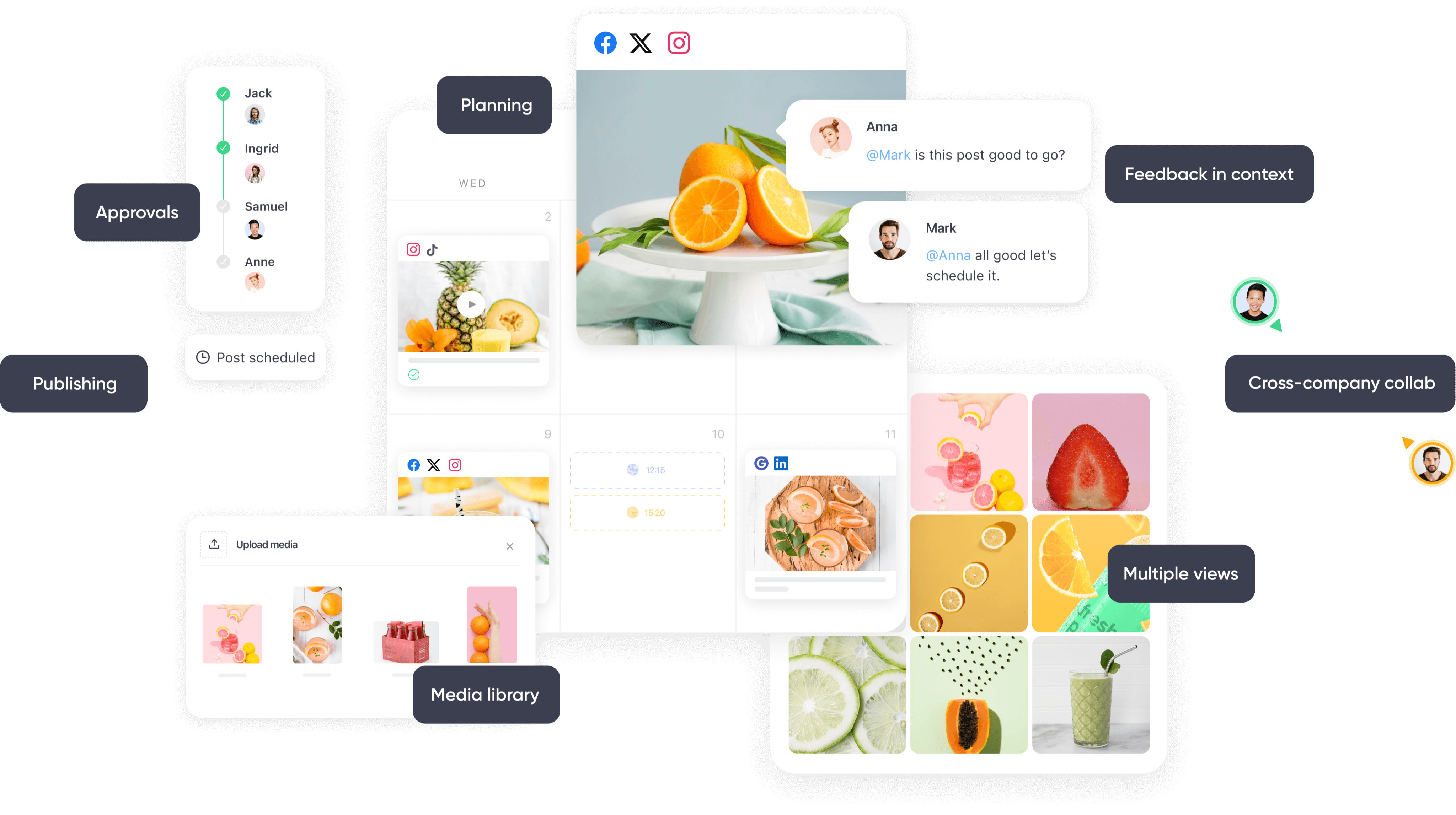

Approvals, publishing, media library, feedback, and collaboration in Planable
Content everywhere, feedback flying around, approvals stuck in endless loops? You, my friend, need technology. But not any tech stack will do. No one has changed tools and tried out more AI-powered solutions in the past year than I have.
A collaboration tool like Planable can clear up the chaos.
- With the Universal Content feature, you’re not just limited to one type of content. Whether it’s newsletters, blogs, or social posts, you can create, manage, and keep all your content in one hub.
- The calendar keeps things on track. Want to plan your newsletter campaign and see how it syncs with your social media push? Done. The calendar view helps you see the big picture and simplify the flow.


Content calendar view in Planable
- With comments, suggestions, and real-time tracking, all feedback stays where it should (next to the content itself). Plus, Planable’s multi-layer approvals make it easy for stakeholders to give the green light without it turning into a committee meeting that could have been an email.
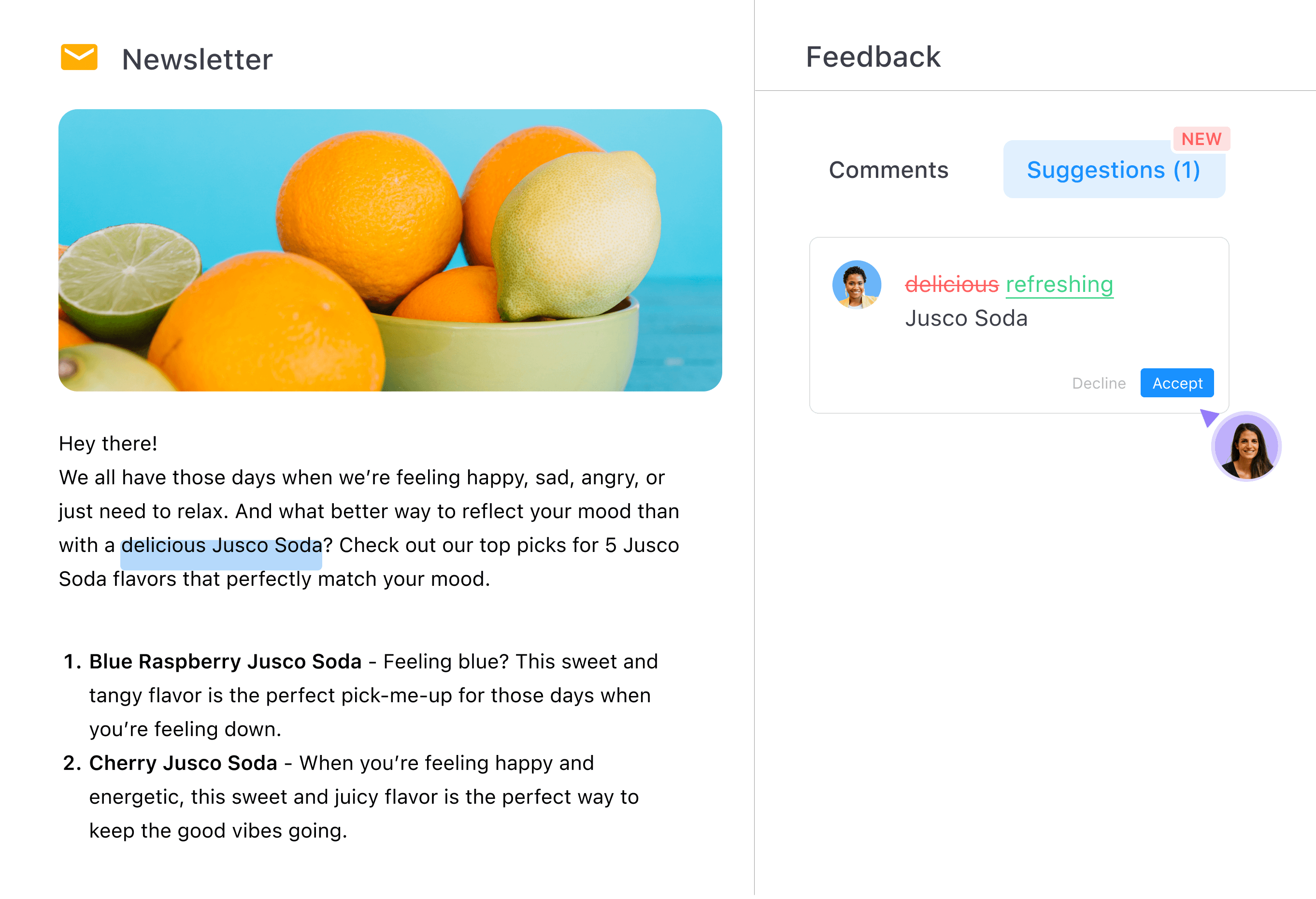

Collaboration on a newsletter in Planable
- Finally, once your newsletter is out in the wild, use Planable’s analytics to measure what social media content performed well. Did that witty Instagram post get a lot of traction? Did your LinkedIn post on a specific topic really take off? Maybe it’s worth repurposing in your next newsletter.
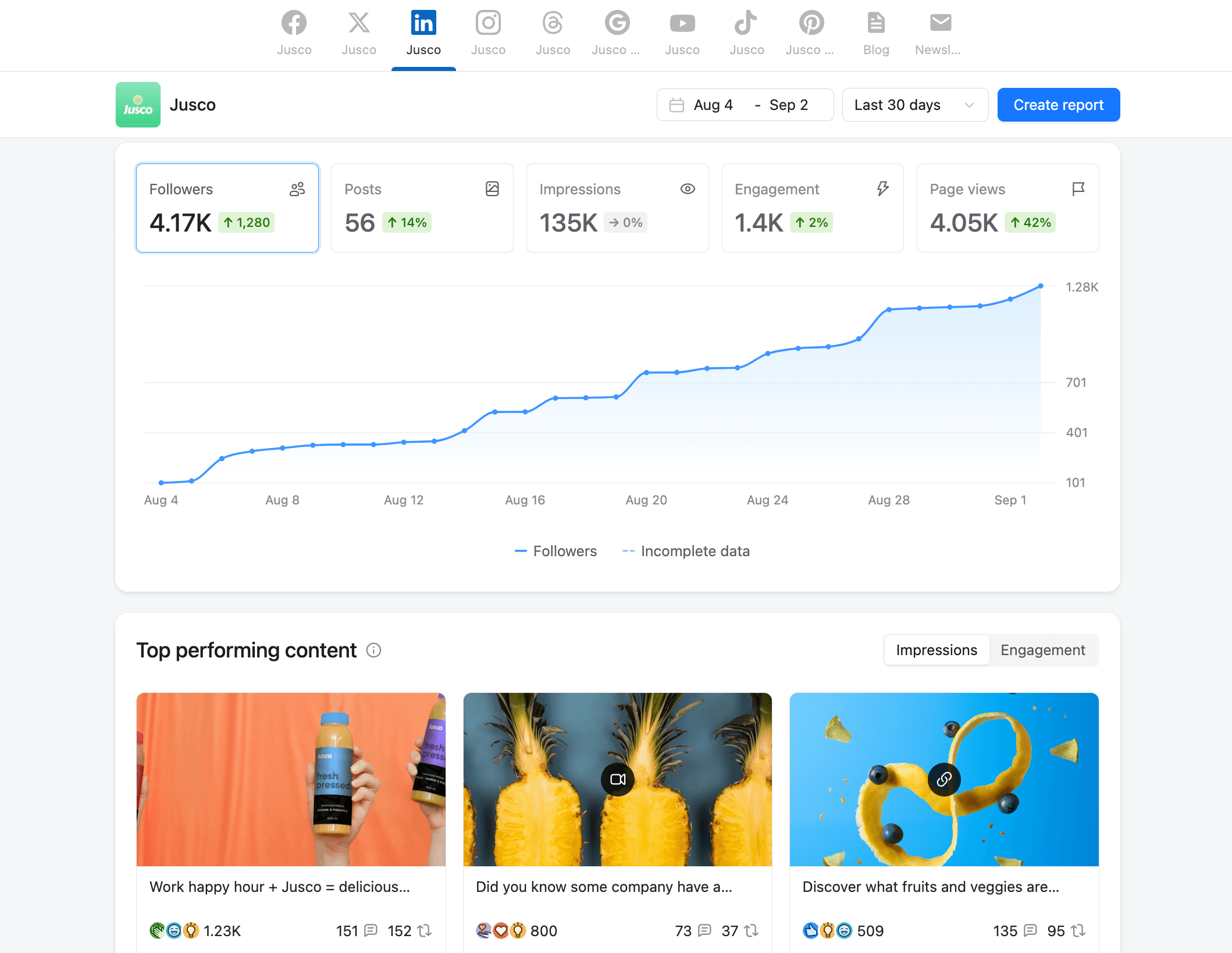

LinkedIn analytics view in Planable
Common newsletter writing mistakes to avoid
Keep in mind that a good newsletter offers value, stays on brand, and keeps your audience engaged without turning it into a novel or a sales pitch.
Here are some of the biggest mistakes to avoid when writing a newsletter:
Newsletters aren’t meant to be essays. Keep it short and punchy. Less is more. Aim for 200 (okay, well, 400 words if you must share free knowledge or market updates) of focused, actionable content.
Don’t bombard your reader with 10 things to click on. Stick to one clear CTA (maybe two if it makes sense). People don’t want to feel like they’re in a maze of links. The more actions you ask your readers to take, the less likely they are to take any.
You wouldn’t text your friend once a year and expect the relationship to thrive. Consistency is key. Set a schedule, like weekly, biweekly, or monthly, and stick to it.
- Forgetting the audience’s needs
Newsletters should be about them, not you. What’s in it for them? Solve their problems, don’t just showcase your wins.
According to Steph Smith, author of Doing Content Right, people usually favor newsletters not for the topics but for how they’re covered. The uniqueness of voice and delivery is what sets a great newsletter apart.
Newsletter content creation FAQs
What is the best structure for a newsletter?
The ideal newsletter structure includes a catchy subject line, a clear header with your brand’s logo, an introduction that hooks the reader, a body of content that delivers value, a strong call-to-action, and a footer with social links or contact details.
How do you format newsletter content?
To make your newsletter easy to read, use clear headings, break content into short paragraphs, and use bullet points for clarity. Visuals like images, icons, or graphs help break up text and improve readability and memorability.
What makes a newsletter stand out?
A great newsletter offers valuable content that resonates with the audience, paired with an eye-catching design. Personalization, such as addressing the reader by name, is a good practice to follow. Consistency in sending frequency builds reader loyalty. Most importantly, a newsletter that addresses a market gap and delivers unique value will stand out.


Maria is a content marketer, SEO copywriter, and social media specialist with experience working for a wide range of B2B businesses. She loves to keep up with the evolution of digital marketing, particularly in areas such as social media management, content, SEO, and PR. She is passionate about her work and loves to add a unique spin to any topic.
